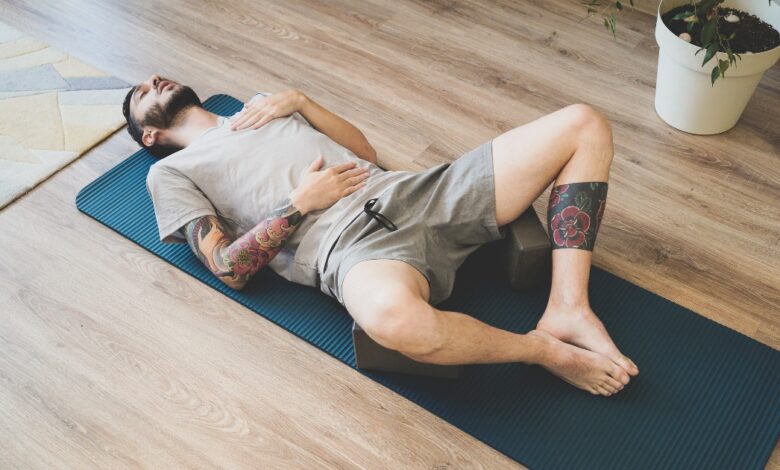10 Breathing Exercises to Try When You’re Feeling Stressed

Stress is a widespread issue with significant implications for health and well-being. Effective stress management techniques are essential, and controlled breathing exercises are among the simplest and most effective methods. These techniques can calm the mind, alleviate anxiety, and induce relaxation.
In this blog post, we will explore ten specific breathing exercises designed to alleviate stress. Each method is straightforward yet powerful, providing quick relief and long-term gains when practiced regularly.
Deep Breathing
Deep breathing is a basic habit of carrying prolonged, gentle, and profound breaths. To perform this technique, find a comfy seated or lying position, place one hand on your chest and the other on your abdomen, and inhale deeply through your nostrils. Focus on allowing your belly to rise above your chest as you inhale. Breathe out gradually using your mouth.
This approach aids in oxygenating the body and soothing the mind by slowing the heart rate and stabilizing blood pressure. Regular deep breathing practice can effectively diminish stress and foster a feeling of calmness.
4-7-8 Breathing
The 4-7-8 breathing technique follows a straightforward sequence: inhale for four seconds, hold for seven seconds, and exhale for eight seconds. Its purpose is to enhance oxygen exchange and stimulate the parasympathetic nervous system, promoting relaxation of both body and mind.
Regular practice of 4-7-8 breathing can lower anxiety levels and enhance concentration, making it particularly beneficial for individuals experiencing significant stress who seek a rapid and effective relaxation method.
Box Breathing
Box breathing, or square breathing, applies a structured pattern of inhaling for four seconds, waiting for four seconds, exhaling for four seconds, and pausing for four seconds before the next cycle begins.
If you find it hard to concentrate while breathing, consider using a breathing tool or application. These tools offer guided breathing sessions and enable practice of various breathing techniques tailored to specific concerns.
This method calms both the mind and body by offering a clear focal point, thereby alleviating stress and anxiety. Box breathing is especially effective for improving concentration and promoting equilibrium, making it an invaluable technique for stress management during demanding circumstances.
Alternate Nostril Breathing
Alternate nostril breathing, or Nadi Shodhana, involves closing one nostril while inhaling through the other, then switching nostrils for the exhale. This exercise helps to equalize the brain’s left and right hemispheres a sense of harmony and comfort.
Alternate nostril breathing is known for reducing stress, enhancing respiratory function, and increasing overall mental clarity. This technique is particularly effective for those seeking a more balanced and centered state of mind.
Pursed Lip Breathing
Alternate nostril breathing, also known as Nadi Shodhana, entails closing one nostril to inhale through the other, then alternating nostrils for the exhale. This practice balances the brain’s left and right hemispheres, fostering relaxation and harmony. Known for its stress-reducing benefits, improved respiratory function, and enhanced mental clarity, alternate nostril breathing is highly effective for achieving a balanced and centered state of mind.
Diaphragmatic Breathing
Diaphragmatic breathing involves emphasizing the movement of the diaphragm rather than the chest. To practice this technique, lie down with your knees bent, put your hands on the chest region and your tummy, and breathe deeply through your nose, paying attention to letting your stomach rise.
This approach facilitates complete oxygen exchange, slows the heart rate, and decreases blood pressure, reducing stress and heightened relaxation. Diaphragmatic breathing is particularly advantageous for individuals managing chronic stress or anxiety.
Resonant or Coherent Breathing
Resonant breathing entails maintaining a steady breathing rhythm, typically inhaling and exhaling for five seconds each. This approach supports heart rate variability and stimulates the vagus nerve, effectively reducing stress and anxiety.
Regular practice of resonant breathing can enhance emotional regulation, promote better sleep, and foster a tranquil mental state. This technique is especially beneficial for individuals seeking to improve their overall well-being by enhancing respiratory function and effectively managing stress.
Humming Bee Breath
Humming bee breath involves deep inhaling through the nose and exhaling while producing a humming sound. Practitioners often close their eyes and gently press their ears with their thumbs during exhalation.
The humming sound and resulting vibrations help to soothe the mind, release tension, and alleviate stress. Bhramari is especially effective for calming the nervous system and promoting mental clarity, making it a beneficial practice for relaxation and concentration.
Lion’s Breath
Lion’s breath requires sitting comfortably, inhaling deeply through the nose, opening the mouth wide, sticking out the tongue, and exhaling forcefully with a “ha” sound. This practice aids in releasing tension in the face and chest, reducing stress, and fostering a playful and relaxed state. It also stimulates the diaphragm and enhances circulation, contributing significantly to stress relief and overall well-being.
Mindful Breathing
Mindful breathing involves focusing on the breath’s natural rhythm and paying close attention to its sensations. To practice, find a comfortable sitting or lying position and concentrate on the air entering and leaving through your nostrils or the movement of your chest or abdomen.
This technique enhances awareness, reduces stress, and cultivates a feeling of tranquility and serenity. As a fundamental aspect of mindfulness and meditation, mindful breathing contributes significantly to overall well-being and mental clarity.
Conclusion
Integrating these ten breathing exercises into your daily schedule can offer substantial stress relief and improve overall well-being. Each technique provides distinct advantages and can be performed anywhere, serving as accessible tools for effective stress management. Consistent practice can enhance mental clarity, emotional stability, and a heightened sense of relaxation.



